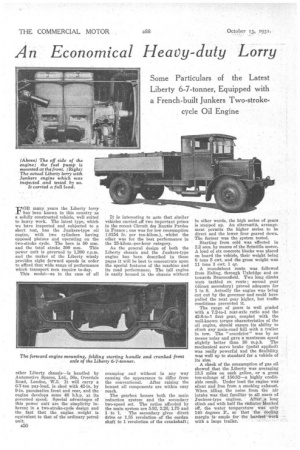An Economical Heavy-duty Lorry
Page 72

If you've noticed an error in this article please click here to report it so we can fix it.
Some Particulars of the Latest Liberty 6-7-tonner, Equipped with a French-built Junkers Two-strokecycle Oil Engine
FOR many, years the Liberty lorry haS been known in this country as a solidly constructed vehicle, well suited to heavy work. The latest type, which we have inspected and subjected to a short test, has the Junkers-type oil engine, -with two cylinders having opposed pistons and operating on the two-stroke eyele. The here is 80 mm. and the total stroke 300 mm. This power unit is governed to 1,200 r.p.m. and the maker of the Liberty wisely provides eight forward speeds in order to afford that wide vange of performance which transport men require to-day.
This model—as in the case of all other Liberty chassis—is handled by Automotive Spares, Ltd., 50a, Overdale Road, London, W.5. It will carry a 6-7-ton pay-load, is shod with 42-in. by 9-in, pneumatics front and rear, and the engine develops some 48 b.h.p. at its governed speed. Special advantages of this power unit arc the simplicity inherent in a two-stroke-cycle design and the fact that the. en,gine .weight is equivalent to that of the ordinary petrol unit.
050 It is interesting to note that similar vehicles carried off two important prizes in the recent Circuit des Routes Payees in Prance; one was for Iow consumption (.0154 fr. per ton-kilom.), whilst the other was for the best performance in the 25-kilom.-per-hour category.
As the general design of both the Liberty chassis and the Junkers-type engine has been described in these pages it will be best to concentrate upon the special features of the machine and its road performance. The tall engine is easily housed in the chassis without cramping and without in any way causing the appearance to differ from the conventional. After raising the bonnet all components are within easy reach.
The gearbox houses both the main reduction systemand the secondary two-speed set. The ratios afforded. by the main system are 5.93,3.26, 1.75 and
1 to 1. The secondary gives direct drive or 1.35 revolution of the cardan shaft to 1 revolution of the crankshaft ; in other words, the high series of gears is stepped up. An alternatiA, arrangement permits the higher series to be direct and the lower four geared down. The former was the system tested.
Starting from cold was effected in 2.2 sees. by means of the Scintilla motor. A load of six concrete blocks was placed on board the vehicle, their weight being 6 tons 5 cwt. and the gross weight was 11 tons 3 cwt. I. qr.
A roundabout route was followed from Ealing, through Uxbridge and on towards Beaconsfield. Two long climbs were tackled en route; second gear (direct secondary) proved adequate for 1 in 8. Actually the engine was being cut out by the governor and could have pulled the next gear higher, but traffic conditions prevented it.
The range of gears is well graded with a 7.2-to-1 rear-axle ratio and the 42.6-to-1 first gear, coupled with the well-known torque characteristics of the oil engine, should ensure its ability to climb any main-road hill with a trailer in tow. The " overdrive" was by no means noisy and gave a maximum speed slightly better than 30 in,p.h. The mechanical servo brake (pedal applied) was really powerful and the flexibility was well up to standard for a vehicle of its size.
A check of the consumption of gas oil showed that the Liberty was averaging 13.5 miles on each gallon, or a gross ton-mileage of 150.52—a highly creditable result. Under load the engine -Was silent and free from a smoking exhaust. When idling. the noise from the air intake was: that-familiar to. all users of Junkers-type engines..' After a long climb and with half the radiator blanked Off, the water temperature was only 140 degrees F., so that the. cooling marginisample for the. hardest Work with a large trailer.












































































































